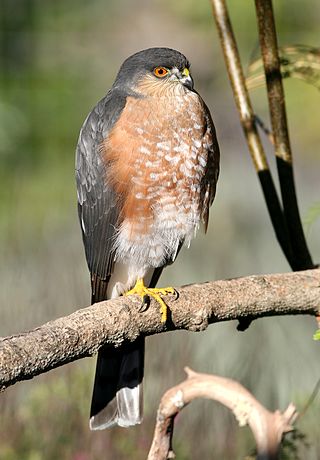
The sharp-shinned hawk or northern sharp-shinned hawk, commonly known as a sharpie, is a small hawk, with males being the smallest hawks in the United States and Canada, but with the species averaging larger than some Neotropical species, such as the tiny hawk. The taxonomy is far from resolved, with some authorities considering the southern taxa to represent three separate species: white-breasted hawk, plain-breasted hawk, and rufous-thighed hawk. The American Ornithological Society and some other checklists keeps all four variations conspecific.

The bat falcon is a bird of prey in the family Falconidae, the falcons and caracaras. It is found in Mexico, Central America, Trinidad, and every mainland South American country except Chile and Uruguay.

The white-winged swallow is a resident breeding swallow in tropical South America from Colombia, Venezuela, Trinidad, and Argentina. It is not found west of the Andes. This swallow is largely non-migratory.
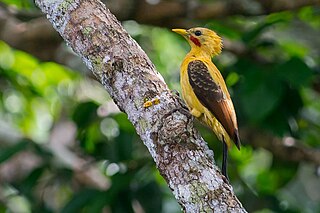
The cream-colored woodpecker is a species of bird in subfamily Picinae of the woodpecker family Picidae. It is found in every mainland South American country except Argentina, Chile, Paraguay, and Uruguay.

The spot-tailed nightjar is a species of nightjar in the family Caprimulgidae. It is found in Honduras, Mexico, Nicaragua, and every mainland South American country except Chile and Uruguay.

The lyre-tailed nightjar is a species of nightjar in the family Caprimulgidae. It is found in Argentina, Bolivia, Colombia, Ecuador, Peru, and Venezuela.

The sharp-billed canastero or lesser canastero is a species of bird in the Furnariinae subfamily of the ovenbird family Furnariidae. It is found in Argentina, Bolivia, Chile, Paraguay, and Uruguay, and has also occurred as a vagrant in Brazil.

The streak-backed canastero is a species of bird in the Furnariinae subfamily of the ovenbird family Furnariidae. It is found in Argentina, Bolivia, Colombia, Ecuador, Peru, and Venezuela.

The buff-winged cinclodes is a species of bird in the Furnariinae subfamily of the ovenbird family Furnariidae. It is found in Argentina, Brazil, Chile, Paraguay, Uruguay and as a vagrant on the Falkland Islands.

The crested hornero is a species of bird in the Furnariinae subfamily of the ovenbird family Furnariidae. It is found in Argentina, Bolivia, and Paraguay.
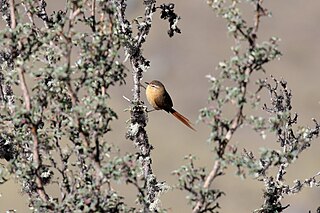
The tawny tit-spinetail is a species of bird in the Furnariinae subfamily of the ovenbird family Furnariidae. It is found in Argentina, Bolivia, and Peru.

The little thornbird is a species of bird in the Furnariinae subfamily of the ovenbird family Furnariidae. It is found in Argentina, Bolivia, Brazil, Paraguay, and Uruguay.

The wren-like rushbird is a species of bird in the Furnariinae subfamily of the ovenbird family Furnariidae. It is found in Argentina, Bolivia, Brazil, Chile, Paraguay, Peru, and Uruguay.
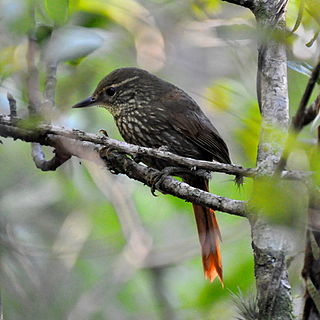
The buff-browed foliage-gleaner is a species of bird in the Furnariinae subfamily of the ovenbird family Furnariidae. It is found in Argentina, Bolivia, Brazil, Ecuador, Paraguay, Peru, and Uruguay.

The white-rumped swallow is a species of bird in the family Hirundinidae. First described and given its binomial name by French ornithologist Louis Pierre Vieillot in 1817, it was for many years considered a subspecies of the Chilean swallow. The species is monotypic with no known population variations. It has a white supraloral streak, or streak above its lores, which can be used to differentiate it from the Chilean swallow. The lores, ear coverts, tail, and wings are black, with white tips on the inner secondaries, tertials, and greater coverts of the wings. The rest of the upperparts are a glossy blue. Its underparts and underwing-coverts are white, in addition to the rump, as the name suggests. The sexes are similar, and the juvenile is duller and browner with a dusky breast.

The Chilean swallow is a species of bird in the family Hirundinidae. It breeds in Chile and Patagonia, migrating north as far as Bolivia, Paraguay, and Rio Grande do Sul.

The rufous-capped antshrike is a species of bird in subfamily Thamnophilinae of family Thamnophilidae, the "typical antbirds". It is found in Argentina, Bolivia, Brazil, Paraguay, Peru, and Uruguay.
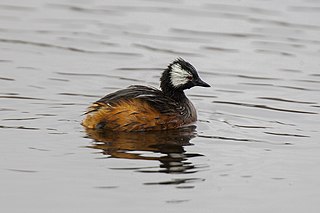
The white-tufted grebe, also known as Rolland's grebe, is a species of grebe in the family Podicipedidae. Found in the southern and western South America, its natural habitat is freshwater lakes, ponds and sluggish rivers and streams.
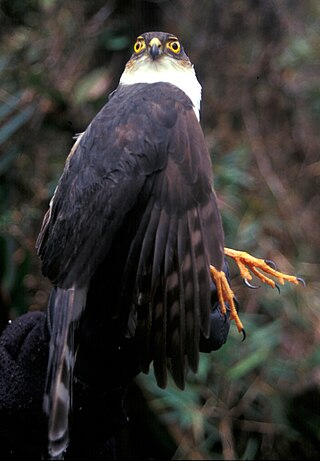
The plain-breasted hawk is a small hawk described from Venezuela to western Bolivia. It is usually considered a subspecies of the sharp-shinned hawk by most taxonomists, including the American Ornithological Society, but the taxonomy is far from resolved, with some authorities considering the southern taxa to represent three separate species: white-breasted hawk, plain-breasted hawk, and rufous-thighed hawk.
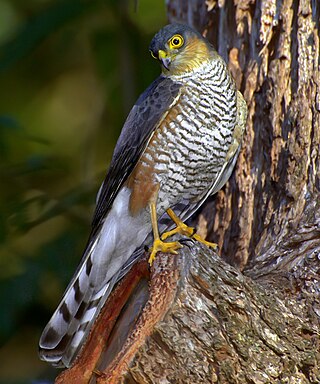
The rufous-thighed hawk is a small hawk found from southern Brazil and southeastern Bolivia to Paraguay, Uruguay and northern Argentina. It is usually considered a subspecies of the sharp-shinned hawk by most taxonomists, including the American Ornithological Society, but the taxonomy is far from resolved, with some authorities considering the southern taxa to represent three separate species: white-breasted hawk, plain-breasted hawk, and rufous-thighed hawk.






















